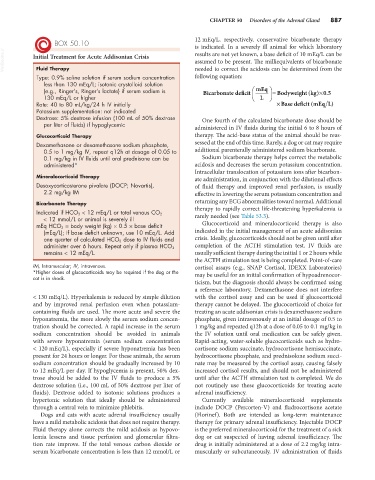Page 915 - Small Animal Internal Medicine, 6th Edition
P. 915
CHAPTER 50 Disorders of the Adrenal Gland 887
12 mEq/L, respectively, conservative bicarbonate therapy
BOX 50.10 is indicated. In a severely ill animal for which laboratory
VetBooks.ir Initial Treatment for Acute Addisonian Crisis results are not yet known, a base deficit of 10 mEq/L can be
assumed to be present. The milliequivalents of bicarbonate
needed to correct the acidosis can be determined from the
Fluid Therapy
Type: 0.9% saline solution if serum sodium concentration following equation:
less than 130 mEq/L; isotonic crystalloid solution
(e.g., Ringer’s, Ringer’s lactate) if serum sodium is Bicarbonate deficit mEq = Bodyweight kg × ) 05
.
(
130 mEq/L or higher L
Rate: 40 to 80 mL/kg/24 h IV initially × Base deficcitmEq L( )
Potassium supplementation: not indicated
Dextrose: 5% dextrose infusion (100 mL of 50% dextrose One fourth of the calculated bicarbonate dose should be
per liter of fluids) if hypoglycemic administered in IV fluids during the initial 6 to 8 hours of
Glucocorticoid Therapy therapy. The acid-base status of the animal should be reas-
Dexamethasone or dexamethasone sodium phosphate, sessed at the end of this time. Rarely, a dog or cat may require
0.5 to 1 mg/kg IV, repeat q12h at dosage of 0.05 to additional parenterally administered sodium bicarbonate.
0.1 mg/kg in IV fluids until oral prednisone can be Sodium bicarbonate therapy helps correct the metabolic
administered* acidosis and decreases the serum potassium concentration.
Intracellular translocation of potassium ions after bicarbon-
Mineralocorticoid Therapy ate administration, in conjunction with the dilutional effects
Desoxycorticosterone pivalate (DOCP; Novartis), of fluid therapy and improved renal perfusion, is usually
2.2 mg/kg IM effective in lowering the serum potassium concentration and
Bicarbonate Therapy returning any ECG abnormalities toward normal. Additional
Indicated if HCO 3 < 12 mEq/L or total venous CO 2 therapy to rapidly correct life-threatening hyperkalemia is
< 12 mmol/L or animal is severely ill rarely needed (see Table 53.3).
mEq HCO 3 = body weight (kg) × 0.5 × base deficit Glucocorticoid and mineralocorticoid therapy is also
(mEq/L); if base deficit unknown, use 10 mEq/L. Add indicated in the initial management of an acute addisonian
one quarter of calculated HCO 3 dose to IV fluids and crisis. Ideally, glucocorticoids should not be given until after
administer over 6 hours. Repeat only if plasma HCO 3 completion of the ACTH stimulation test. IV fluids are
remains < 12 mEq/L. usually sufficient therapy during the initial 1 or 2 hours while
the ACTH stimulation test is being completed. Point-of-care
IM, Intramuscular; IV, intravenous. cortisol assays (e.g., SNAP Cortisol, IDEXX Laboratories)
*Higher doses of glucocorticoids may be required if the dog or the may be useful for an initial confirmation of hypoadrenocor-
cat is in shock.
ticism, but the diagnosis should always be confirmed using
a reference laboratory. Dexamethasone does not interfere
< 130 mEq/L). Hyperkalemia is reduced by simple dilution with the cortisol assay and can be used if glucocorticoid
and by improved renal perfusion even when potassium- therapy cannot be delayed. The glucocorticoid of choice for
containing fluids are used. The more acute and severe the treating an acute addisonian crisis is dexamethasone sodium
hyponatremia, the more slowly the serum sodium concen- phosphate, given intravenously at an initial dosage of 0.5 to
tration should be corrected. A rapid increase in the serum 1 mg/kg and repeated q12h at a dose of 0.05 to 0.1 mg/kg in
sodium concentration should be avoided in animals the IV solution until oral medication can be safely given.
with severe hyponatremia (serum sodium concentration Rapid-acting, water-soluble glucocorticoids such as hydro-
< 120 mEq/L), especially if severe hyponatremia has been cortisone sodium succinate, hydrocortisone hemisuccinate,
present for 24 hours or longer. For these animals, the serum hydrocortisone phosphate, and prednisolone sodium succi-
sodium concentration should be gradually increased by 10 nate may be measured by the cortisol assay, causing falsely
to 12 mEq/L per day. If hypoglycemia is present, 50% dex- increased cortisol results, and should not be administered
trose should be added to the IV fluids to produce a 5% until after the ACTH stimulation test is completed. We do
dextrose solution (i.e., 100 mL of 50% dextrose per liter of not routinely use these glucocorticoids for treating acute
fluids). Dextrose added to isotonic solutions produces a adrenal insufficiency.
hypertonic solution that ideally should be administered Currently available mineralocorticoid supplements
through a central vein to minimize phlebitis. include DOCP (Percorten-V) and fludrocortisone acetate
Dogs and cats with acute adrenal insufficiency usually (Florinef). Both are intended as long-term maintenance
have a mild metabolic acidosis that does not require therapy. therapy for primary adrenal insufficiency. Injectable DOCP
Fluid therapy alone corrects the mild acidosis as hypovo- is the preferred mineralocorticoid for the treatment of a sick
lemia lessens and tissue perfusion and glomerular filtra- dog or cat suspected of having adrenal insufficiency. The
tion rate improve. If the total venous carbon dioxide or drug is initially administered at a dose of 2.2 mg/kg intra-
serum bicarbonate concentration is less than 12 mmol/L or muscularly or subcutaneously. IV administration of fluids

